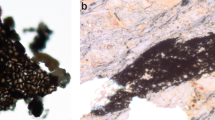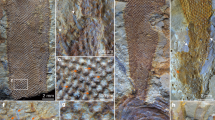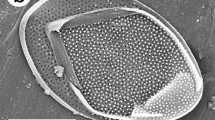Abstract
Chlorophytes (representing a clade within the Viridiplantae and a sister group of the Streptophyta) probably dominated marine export bioproductivity and played a key role in facilitating ecosystem complexity before the Mesozoic diversification of phototrophic eukaryotes such as diatoms, coccolithophorans and dinoflagellates. Molecular clock and biomarker data indicate that chlorophytes diverged in the Mesoproterozoic or early Neoproterozoic, followed by their subsequent phylogenetic diversification, multicellular evolution and ecological expansion in the late Neoproterozoic and Palaeozoic. This model, however, has not been rigorously tested with palaeontological data because of the scarcity of Proterozoic chlorophyte fossils. Here we report abundant millimetre-sized, multicellular and morphologically differentiated macrofossils from rocks approximately 1,000 million years ago. These fossils are described as Proterocladus antiquus new species and are interpreted as benthic siphonocladalean chlorophytes, suggesting that chlorophytes acquired macroscopic size, multicellularity and cellular differentiation nearly a billion years ago, much earlier than previously thought.
This is a preview of subscription content, access via your institution
Access options
Access Nature and 54 other Nature Portfolio journals
Get Nature+, our best-value online-access subscription
$29.99 / 30 days
cancel any time
Subscribe to this journal
Receive 12 digital issues and online access to articles
$119.00 per year
only $9.92 per issue
Buy this article
- Purchase on Springer Link
- Instant access to full article PDF
Prices may be subject to local taxes which are calculated during checkout




Similar content being viewed by others
Data availability
All specimens illustrated in this paper are reposited and available at Virginia Polytechnic Institute Geoscience Museum (Blacksburg, VA, USA; museum catalogue nos. VPIGM-4749–4794 and VPIGM-4799).
References
Falkowski, P. G. et al. The evolution of modern eukaryotic phytoplankton. Science 305, 354–360 (2004).
Keeling, P. J. The number, speed, and impact of plastid endosymbioses in eukaryotic evolution. Annu. Rev. Plant Biol. 64, 583–607 (2013).
Brocks, J. J. et al. The rise of algae in Cryogenian oceans and the emergence of animals. Nature 548, 578–581 (2017).
Knoll, A. H., Summons, R. E., Waldbauer, J. R. & Zumberge, J. E. in Evolution of Primary Producers in the Sea (eds Falkowski, P. G. & Knoll, A. H.) 133–163 (Academic Press, 2007).
Parfrey, L. W., Lahr, D. J. G., Knoll, A. H. & Katz, L. A. Estimating the timing of early eukaryotic diversification with multigene molecular clocks. Proc. Natl Acad. Sci. USA 108, 13624–13629 (2011).
Sánchez-Baracaldo, P., Raven, J. A., Pisani, D. & Knoll, A. H. Early photosynthetic eukaryotes inhabited low-salinity habitats. Proc. Natl Acad. Sci. USA 114, E7737–E7745 (2017).
Gibson, T. M. et al. Precise age of Bangiomorpha pubescens dates the origin of eukaryotic photosynthesis. Geology 46, 135–138 (2017).
Fučíková, K. et al. New phylogenetic hypotheses for the core Chlorophyta based on chloroplast sequence data. Front. Ecol. Evol. 2, 63 (2014).
Jackson, C., Knoll, A. H., Chan, C. X. & Verbruggen, H. Plastid phylogenomics with broad taxon sampling further elucidates the distinct evolutionary origins and timing of secondary green plastids. Sci. Rep. 8, 1523 (2018).
Del Cortona, A. et al. Neoproterozoic origin and multiple transitions to macroscopic growth in green seaweeds. Proc. Natl Acad. Sci. USA https://doi.org/10.1073/pnas.1910060117 (2020).
Berney, C. & Pawlowski, J. A molecular time-scale for eukaryote evolution recalibrated with the continuous microfossil record. Proc. R. Soc. B. 273, 1867–1872 (2006).
Verbruggen, H. et al. A multi-locus time-calibrated phylogeny of the siphonous green algae. Mol. Phylogenet. Evol. 50, 642–653 (2009).
Morris, J. L. et al. The timescale of early land plant evolution. Proc. Natl Acad. Sci. USA 115, E2274–E2283 (2018).
Bengtson, S., Sallstedt, T., Belivanova, V. & Whitehouse, M. Three-dimensional preservation of cellular and subcellular structures suggests 1.6 billion-year-old crown-group red algae. PLoS Biol. 15, e2000735 (2017).
Betts, H. C. et al. Integrated genomic and fossil evidence illuminates life’s early evolution and eukaryote origin. Nat. Ecol. Evol. 2, 1556–1562 (2018).
Xiao, S. et al. The Weng’an biota and the Ediacaran radiation of multicellular eukaryotes. Natl Sci. Rev. 1, 498–520 (2014).
Butterfield, N. J., Knoll, A. H. & Swett, K. Paleobiology of the Neoproterozoic Svanbergfjellet formation, Spitsbergen. Fossils Strata 34, 1–84 (1994).
Graham, L. E. Digging deeper: why we need more Proterozoic algal fossils and how to get them. J. Phycol. 55, 1–6 (2019).
Marshall, C. R. Confidence intervals on stratigraphic ranges. Paleobiology 16, 1–10 (1990).
Zumberge, J. A., Rocher, D. & Love, G. D. Free and kerogen-bound biomarkers from late Tonian sedimentary rocks record abundant eukaryotes in mid-Neoproterozoic marine communities. Geobiology https://doi.org/10.1111/gbi.12378 (2019).
Gueneli, N. et al. 1.1-billion-year-old porphyrins establish a marine ecosystem dominated by bacterial primary producers. Proc. Natl Acad. Sci. USA 115, E6978–E6986 (2018).
Hoshino, Y. et al. Cryogenian evolution of stigmasteroid biosynthesis. Sci. Adv. 3, e1700887 (2017).
Zhang, S.-H., Zhao, Y., Ye, H. & Hu, G.-H. Early Neoproterozoic emplacement of the diabase sill swarms in the Liaodong Peninsula and pre-magmatic uplift of the southeastern North China Craton. Precambrian Res. 272, 203–225 (2016).
Bureau of Geology and Mineral Resources of Liaoning Province Regional Geology of Liaoning Province Chinese Ministry of Geology and Mineral Resources, Geological Memoirs, Series 1, No. 5 (Geological Publishing House, 1989).
Yang, D.-B. et al. U-Pb ages and Hf isotope data from detrital zircons in the Neoproterozoic sandstones of northern Jiangsu and southern Liaoning Provinces, China: implications for the late Precambrian evolution of the southeastern North China Craton. Precambrian Res. 216–219, 162–176 (2012).
Zhao, H. et al. New geochronologic and paleomagnetic results from early Neoproterozoic mafic sills and late Mesoproterozoic to early Neoproterozoic successions in the eastern North China Craton, and implications for the reconstruction of Rodinia. Geol. Soc. Am. Bull. https://doi.org/10.1130/B35198.1 (2019).
Pascher, A. Uber Flagellaten und Algen. Ber. Dtsch. Bot. Ges. 32, 136–160 (1914).
Mattox, K. R. & Stewart, K. D. in Systematics of the Green Algae (eds Irvine, D. E. G. & John, D. M.) 29–72 (Academic Press, 1984).
Oltmanns, F. Morphologie und Biologie der Algen Vol. 1 (Gustav Fischer, 1904).
Zhao, Z.-J., Zhu, H., Liu, G.-X. & Hu, Z.-Y. Rhizoclonium ramosum sp. nov. (Cladophorales, Chlorophyta), a new freshwater algal species from China. Fottea (Praha) 16, 12–21 (2016).
Zhu, H. et al. Molecular phylogeny and morphological diversity of inland Cladophora (Cladophorales, Ulvophyceae) from China. Phycologia 57, 191–208 (2018).
Okuda, K. et al. Segregative cell division and the cytoskeleton in two species of the genus Struvea (Cladophorales, Ulvophyceae, Chlorophyta). Phycol. Res. 64, 219–229 (2016).
Leliaert, F. & Coppejans, E. A revision of Cladophoropsis Børgesen (Siphonocladales, Chlorophyta). Phycologia 45, 657–679 (2006).
Hermann, T. N. & Podkovyrov, V. N. A discovery of Riphean heterotrophs in the Lakhanda Group of Siberia. Paleontol. J. 44, 374–383 (2010).
Hermann, T. N. Filamentous microorganisms in the Lakhanda Formation on the Maya River. Paleontol. J. 1981, 100–107 (1981).
Nowak, H. et al. Filamentous eukaryotic algae with a possible cladophoralean affinity from the Middle Ordovician Winneshiek Lagerstätte in Iowa, USA. Geobios 50, 303–309 (2017).
Wellman, C. H. & Strother, P. K. The terrestrial biota prior to the origin of land plants (embryophytes): a review of the evidence. Palaeontology 58, 601–627 (2015).
Nagovitsin, K. E. et al. Revised Neoproterozoic and Terreneuvian stratigraphy of the Lena-Anabar Basin and north-western slope of the Olenek Uplift, Siberian Platform. Precambrian Res. 270, 226–245 (2015).
Xiao, S. & Tang, Q. After the boring billion and before the freezing millions: evolutionary patterns and innovations in the Tonian Period. Emerg. Top. Life Sci. 2, 161–171 (2018).
Fryxell, G. A. Survival Strategies of the Algae (Cambrian Univ. Press, 1983).
Komárek, J. & Johansen, J. R. in Freshwater Algae of North America 2nd edn (eds Wehr, J. D. et al.) 135–235 (Academic Press, 2015).
Bartley, J. K. Actualistic taphonomy of cyanobacteria: implications for the Precambrian fossil record. Palaios 11, 571–586 (1996).
Niklas, K. J. & Newman, S. A. The origins of multicellular organisms. Evol. Dev. 15, 41–52 (2013).
Roper, M., Ellison, C., Taylor, John, W. & Glass, N. L. Nuclear and genome dynamics in multinucleate ascomycete fungi. Curr. Biol. 21, R786–R793 (2011).
Randhawa, M. S. Akinete formation in Vaucheria geminata. Bot. Gaz. 103, 809–811 (1942).
Duffield, E. C. S., Waaland, S. D. & Cleland, R. Morphogenesis in the red alga, Griffithsia pacifica: regeneration from single cells. Planta 105, 185–195 (1972).
Deacon, J. Fungal Biology 4th edn (Blackwell Publishing, 1997).
Willetts, H. J. & Wong, A. L. Ontogenetic diversity of sclerotia of Sclerotinia sclerotiorum and related species. Trans. Br. Mycol. Soc. 57, 515–524 (1971).
Butterfield, N. J. A vaucheriacean alga from the middle Neoproterozoic of Spitsbergen: implications for the evolution of Proterozoic eukaryotes and the Cambrian explosion. Paleobiology 30, 231–252 (2004).
Graham, L. E. & Wilcox, L. E. Algae (Prentice-Hall, 2000).
Butterfield, N. J. Bangiomorpha pubescens n. gen., n. sp.: implications for the evolution of sex, multicellularity, and the Mesoproterozoic–Neoproterozoic radiation of eukaryotes. Paleobiology 26, 386–404 (2000).
Shih, P. M. & Matzke, N. J. Primary endosymbiosis events date to the later Proterozoic with cross-calibrated phylogenetic dating of duplicated ATPase proteins. Proc. Natl Acad. Sci. USA 110, 12355–12360 (2013).
Moczydlowska, M., Landing, E., Zang, W. & Palacios, T. Proterozoic phytoplankton and timing of Chlorophyte algae origins. Palaeontology 54, 721–733 (2011).
Butterfield, N. J. Proterozoic photosynthesis—a critical review. Palaeontology 58, 953–972 (2015).
Knoll, A. H. Paleobiological perspectives on early eukaryotic evolution. Cold Spring Harb. Perspect. Biol. 6, a016121 (2014).
Butterfield, N. J. Early evolution of the Eukaryota. Palaeontology 58, 5–17 (2015).
Leliaert, F. et al. Phylogeny and molecular evolution of the green algae. Crit. Rev. Plant Sci. 31, 1–46 (2012).
Fang, L., Leliaert, F., Zhang, Z.-H., Penny, D. & Zhong, B.-J. Evolution of the Chlorophyta: insights from chloroplast phylogenomic analyses. J. Syst. Evol. 55, 322–332 (2017).
Cocquyt, E., Verbruggen, H., Leliaert, F. & De Clerck, O. Evolution and cytological diversification of the green seaweeds (Ulvophyceae). Mol. Biol. Evol. 27, 2052–2061 (2010).
Umen, J. G. Green algae and the origins of multicellularity in the plant kingdom. Cold Spring Harb. Perspect. Biol. 6, a016170 (2014).
Butterfield, N. J. Oxygen, animals and aquatic bioturbation: an updated account. Geobiology 16, 3–16 (2018).
Gold, D. A. et al. Sterol and genomic analyses validate the sponge biomarker hypothesis. Proc. Natl Acad. Sci. USA 113, 2684–2689 (2016).
Zumberge, J. A. et al. Demosponge steroid biomarker 26-methylstigmastane provides evidence for Neoproterozoic animals. Nat. Ecol. Evol. 2, 1709–1714 (2018).
Bunt, J. S. in Primary Productivity of the Biosphere (eds Lieth, H. & Whittaker, R. H.) 169–183 (Springer, 1975).
Loron, C. C. et al. Early fungi from the Proterozoic era in Arctic Canada. Nature 570, 232–235 (2019).
Schuster, A. et al. Divergence times in demosponges (Porifera): first insights from new mitogenomes and the inclusion of fossils in a birth–death clock model. BMC Evol. Biol. 18, 114 (2018).
Cole, D. B. et al. A shale-hosted Cr isotope record of low atmospheric oxygen during the Proterozoic. Geology 7, 555–558 (2016).
Tang, Q. et al. Organic-walled microfossils from the early Neoproterozoic Liulaobei Formation in the Huainan region of North China and their biostratigraphic significance. Precambrian Res. 236, 157–181 (2013).
Tsutsui, I. et al. Ecological and morphological profile of floating spherical Cladophora socialis aggregations in central Thailand. PLoS ONE 10, e0124997 (2015).
Parial, D. & Pal, R. Biosynthesis of monodisperse gold nanoparticles by green alga Rhizoclonium and associated biochemical changes. J. Appl. Phycol. 27, 975–984 (2015).
Zhao, Z.-J., Zhu, H., Hu, Z.-Y. & Liu, G.-X. Occurrence of true branches in Rhizoclonium (Cladophorales, Ulvophyceae) and the reinstatement of Rhizoclonium pachydermum Kjellman. Phytotaxa 166, 273–284 (2014).
Wang, Y., Xu, H.-H., Wang, Y. & Fu, Q. A further study of Zosterophyllum sinense Li and Cai (Zosterophyllopsida) based on the type and the new specimens from the Lower Devonian of Guangxi, southwestern China. Rev. Palaeobot. Palynol. 258, 112–122 (2018).
Acknowledgements
S.X. and Q.T. were supported by NASA Exobiology and Evolutionary Biology (grant no. 80NSSC18K1086). X.Y. and K.P. were supported by the National Natural Science Foundation of China (grant nos. 41602007 and 41921002), the Chinese Academy of Sciences (grant nos. QYZDJ-SSW-DQC009 and XDB26000000), the National Key Research and Development Programme of China (grant no. 2017YFC0603100), the Science Foundation of Jiangsu Province of China (grant no. BK20161090) and the State Key Laboratory of Palaeobiology and Stratigraphy of the Nanjing Institute of Geology and Palaeontology (grant nos. 193126 and 20162109). We thank J. Wang for field assistance.
Author information
Authors and Affiliations
Contributions
Q.T. and S.X. designed the research. Q.T. and K.P. conducted fieldwork. Q.T. conducted microscopic observation. S.X. and Q.T. developed the interpretation and prepared the manuscript with input from other co-authors.
Corresponding authors
Ethics declarations
Competing interests
The authors declare no competing interests.
Additional information
Publisher’s note Springer Nature remains neutral with regard to jurisdictional claims in published maps and institutional affiliations.
Extended data
Extended Data Fig. 1 Geological map and stratigraphic column of Proterozoic successions in southern Liaoning Province, North China.
Question mark in stratigraphic column denotes poor age constraint on the Dalinzi Formation, which could be either Neoproterozoic or Cambrian in age. Stars in geological map and stratigraphic column mark sample locality (near Shileicun, 39°35.6566’N, 121°35.8379’E) and sample horizon, respectively. Ca=Cambrian, Pa=Paleoproterozoic, Fm=Formation, CLZ=Changlingzi, NGL=Nanguanling, GJZ=Ganjingzi, YCZ=Yingchengzi, SSLT=Shisanlitai, MJT=Majiatun, CJT=Cuijiatun, XMC=Xingmincun, GT=Getun. Radiometric ages (924 ± 5 Ma and 947.8 ± 7.4 Ma) of diabase sills emplaced in the Cuijiatun and Qiaotou formations are from ref. 22 and ref. 25; detrital zircon ages (<924 ± 25 Ma and <1056 ± 22 Ma) are from ref. 24. See ref. 25 for a compilation of ratiometric ages from Neoproterozoic successions in North China. Geological map drawn by authors based on ref. 22 with permission, and stratocolumn drawn by authors.
Extended Data Fig. 2 Proterocladus antiquus new species on bedding surface, showing lateral branches.
a–f, VPIGM-4763, VPIGM-4764, VPIGM-4765, VPIGM-4766, VPIGM-4767, and VPIGM-4768, respectively. All photos taken by authors.
Extended Data Fig. 3 P. antiquus preserved on bedding surface, showing multiple orders of lateral branches (a) and aggregates of thalli (b–d).
a–d, VPIGM-4769, VPIGM-4770, VPIGM-4771, and VPIGM-4772, respectively. All photos taken by authors.
Extended Data Fig. 4 Thallus of P. antiquus with a sub-discoid holdfast preserved on bedding surface.
b is a close-up view of labeled black frame in a. VPIGM-4773. All photos taken by authors.
Extended Data Fig. 5 Heteromorphic cells (a–l) and reproductive cells (m–o) of P. antiquus.
a–l, Filaments with globose (yellow arrowheads), clavate (black arrowheads), doliform (cyan arrowheads), and cyathiform (blue arrowhead) heteromorphic cells. b, k are magnifications of labeled frames in a and j, respectively. VPIGM-4774, VPIGM-4775, VPIGM-4776, VPIGM-4777, VPIGM-4778, VPIGM-4779, VPIGM-4780, VPIGM-4781, VPIGM-4782, and VPIGM-4783, respectively. m–o, Inferred reproductive cells with minute lateral pores (blue arrows), possibly representing openings through which reproductive gametes or zoospores were released. VPIGM-4784, VPIGM-4785, and VPIGM-4786, respectively. Specimens in a and j were photographed on bedding surface, and all other specimens were extracted from the rock matrix using HF acid maceration technique. All scale bars equal 100 µm unless otherwise specified. All photos taken by authors.
Extended Data Fig. 6 Cell branching pattern and apical extensions in extracted specimens of P. antiquus.
a–c, Fragmented filaments with unilateral (a, c) and alternate branches (two lower lateral branches in b). VPIGM-4787, VPIGM-4788, and VPIGM-4789, respectively. d–e, Branching filaments with an inflated apical cell subtending a narrower apical extension (purple arrowhead in d) and an apical cell with septum and constriction (black arrows in e), which is interpreted to have developed from an apical extension. VPIGM-4790 and VPIGM-4791, respectively. All scale bars equal 100 µm. All photos taken by authors.
Extended Data Fig. 7 Branching thallus of P. antiquus with a cell (in black frame) that has a distinct constriction at base (blue arrowhead).
The branching pattern is superficially similar to H-shaped branching in the early vascular plant Zosterophyllum72. b is a magnification of white box in a, showing the basal constriction of the cell that initially may represent an apical extension that subsequently develops septa and branches at maturation. VPIGM-4792. All photos taken by authors.
Extended Data Fig. 8 Dense population of fragmented P. antiquus specimens preserved on bedding surface.
VPIGM-4793. All photos taken by authors.
Extended Data Fig. 9 Taphonomy of P. antiquus preserved in the Nanfen mudstone.
a, b, A partially exposed specimen. b is a backscattered electron scanning electron microscopy (BSEM) photograph of the same specimen in a. VPIGM-4794. c, Energy dispersive X-ray spectroscopy (EDS) point analysis at the blue spot in b, showing the presence of carbon in the fossil specimen. Horizontal axis is energy in KeV, and vertical axis is counts in arbitrary scale. d, EDS elemental maps of labeled box in b, showing the enrichment in C and deficiency in O, Al, and Si in fossil relative to matrix. e–g, Nanfen mudstone fractured obliquely relative to bedding plane, showing darker-colored fossil layers and lighter-colored background layers. f and g are magnifications of labeled boxes in e. h–i, Polished slab cut perpendicular to bedding surface, showing darker-colored fossil layers and lighter-colored background layers. i is a close-up view of labeled box in h with blue arrowheads denoting fragmented fossils in a fossil layer. All photos taken by authors.
Supplementary information
Supplementary Information
Supplementary Table 1. Stratigraphy and sedimentary environment, age constraints, taphonomy and references.
Rights and permissions
About this article
Cite this article
Tang, Q., Pang, K., Yuan, X. et al. A one-billion-year-old multicellular chlorophyte. Nat Ecol Evol 4, 543–549 (2020). https://doi.org/10.1038/s41559-020-1122-9
Received:
Accepted:
Published:
Issue Date:
DOI: https://doi.org/10.1038/s41559-020-1122-9
This article is cited by
-
Fossil-calibrated molecular clock data enable reconstruction of steps leading to differentiated multicellularity and anisogamy in the Volvocine algae
BMC Biology (2024)
-
Tonian carbonaceous compressions indicate that Horodyskia is one of the oldest multicellular and coenocytic macro-organisms
Communications Biology (2023)
-
Phylotranscriptomics unveil a Paleoproterozoic-Mesoproterozoic origin and deep relationships of the Viridiplantae
Nature Communications (2023)
-
Lost world of complex life and the late rise of the eukaryotic crown
Nature (2023)
-
ATP synthase evolution on a cross-braced dated tree of life
Nature Communications (2023)



